Saws, costly or inexpensive – Two extreme saws for you
For more information on saws, see our beginner site Common Woodworking.
I know of two saws by modern makers that anyone would love to own. Both are well worth the money and both are proudly made in the USA. Does anyone remember those campaigns in the US and Britain. In Walmart one day in the lat 80’s it said on every item ‘Proudly made in the USA’. In Britain it said, “I’m backing Britain.” The next day all of that domestic loyalty was gone and everything sold on both continents was import and now in Britain this week the big boast is that consumerism is bailing us out of the debt crisis. How that works I’ll never know. Well, back to sanity.
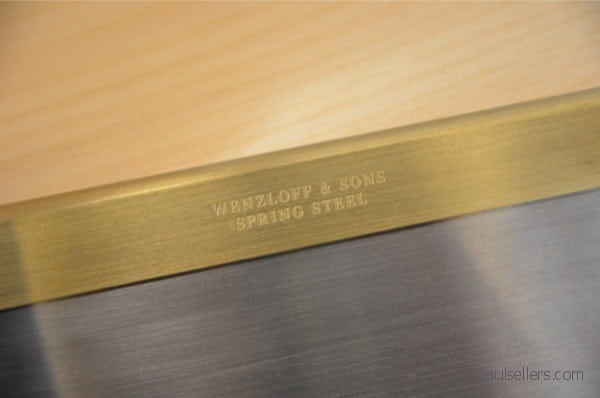
There’s a wonderful American-made saw made by Wenzloff that few if any could ever fault. Its flawless design parallels the early makers of the 1700’s and holding one in your hands, as a craftsman anyway, is the equivalent of riding downhill for your very first down-hill ride on a two-wheeler. It just glides into and out of wood with the same freedom!
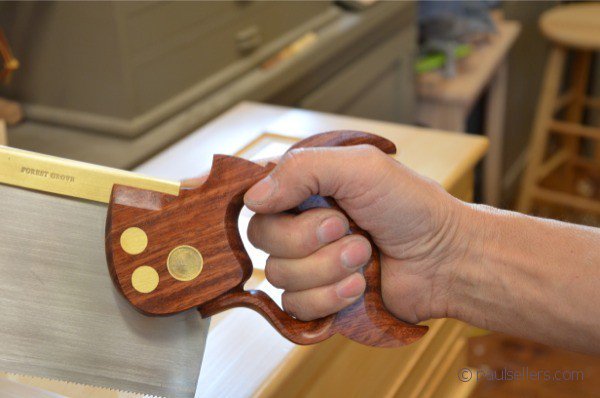
Saws often grab my attention for good, bad and indifferent reasons. I love the symmetry of saws. I love sharpening them even though I have sharpened them thousands of times and I love the thought that a saw, like the ones I own from the 1700’s, 1800’s and 1900’s, continue day in and day out to provide my daily at-the-bench sawing needs. The Wenzloff saw fits my large hand perfectly and it feels like silk.
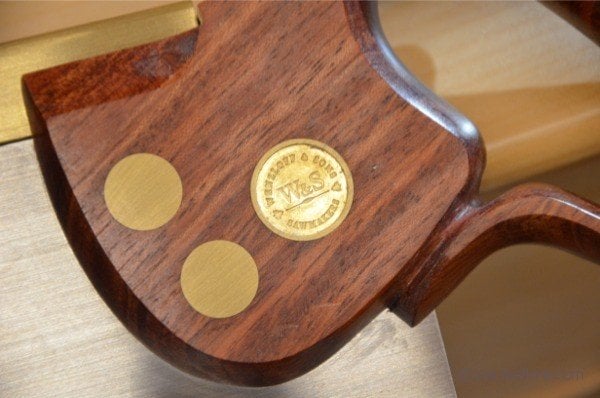
When Mike Wenzloff started his Wenzloff & Sons saw company he strove for levels of perfection and excellence that put modern-day European and British saw makers to shame and he has indeed held the standard even though they are the very newest kids on the saw making block. Mike started from scratch and began making saws for the public after developing a highly refined and well made product ready for launch in 2005. He continued to develop his replica designs of the very finest makers and progressed his methods of production with a determination to make the absolute best saws possible for the best price such an endeavour could. Today he barely keeps pace with demand and if you order you order knowing that this is not an off-the-shelf item in any big-box company store but one well worth waiting for. There are a few makers of fine saws out there. Mainly in the USA for some reason. In Britain we once had two dozen or so but they disappeared one by one, such is our British demise in industry. One day I hope I will own a Wenzloff saw. I don’t want to be avaricious but they are very lovely saws.
I also want to tell you about a little saw I mentioned somewhere in my blog before and some of you will know about. It’s far from pretty, looks inexpensive and you might wonder at its fitness for purpose but it’s one saw I have used for 20 years now and it’s a unique saw I recommend you buy.
I own several of these saws in different sizes and I use them quite frequently. I recently discovered that Chronos here in the UK sell the line of this US maker and I ordered mine from them. Zona saws have been around the Hobby World of woodworking for decades and indeed for model makers and engineers making all kinds of wooden parts to build such things as parts for planes these saws know no equal. As I say, I have used them for two decades and this week I bought yet another to add to my small saw arsenal. These saws have highly refined cutting teeth that cut a glass-smooth cut quickly and effectively. The one I am recommending as a starter is the 24TPI with the reference here.
Retrofitting the saw
I find that these saws have much less power on the pull stroke and cut at about half the rate of a push stroke. These saws are indeed set up with a pull and not a push stroke, but it’s quick and simple to pull the plate out and reverse it for optimum performance. Grip the plate in the vise along its length and pull the handle firmly upwards. Turn the handle and bar end for end and replace but make certain you begin at the handle end to make sure it goes in at the right point. Tap the back onto the blade plate with a plastic-headed hammer and you are good to go.

I also like to transform the handle by turning it on the lathe and adding a brass ferrule instead of the steel one as I did in the last image below.
The reason I chose this particular saw is that the plate is thin but thick enough to cut into hardwoods. Zona make other saws with thinner plate stock for cutting woods like balsa. These are fine too, it’s when you come to hardwoods and pines with hard and soft aspects to the growth rings that they tend to deviate according to resistance. The saw given will not flex in the cut and cuts pristinely in hard and soft woods. The depth of cut is limited to 22mm (7/8”) which is very adequate for 99% of dovetailing as most dovetails are cut in wood less than 25mm (1″). Anything larger would need a bigger and heftier saw anyway. The cost at around £10 is more than a good price and even though the teeth are too small for general hand sharpening (unless you are a watchmaker), the saw should last you for many years of use if you are careful with it.
Zona does make deeper saws and longer saws too. The above saws are about 7″ long and that’s a good and practical length for close work. You can but the Zona saws with 42 teeth per inch I think. This is very fine.


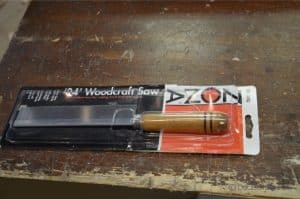
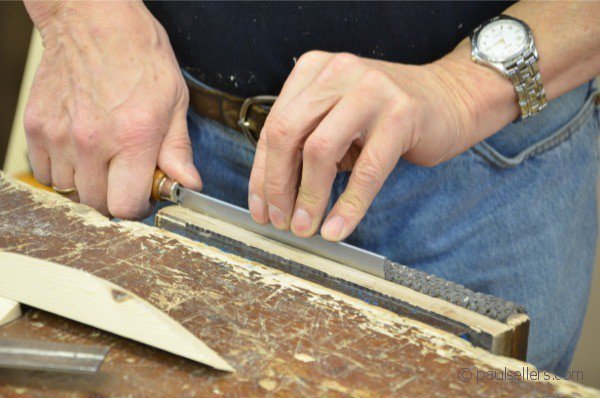

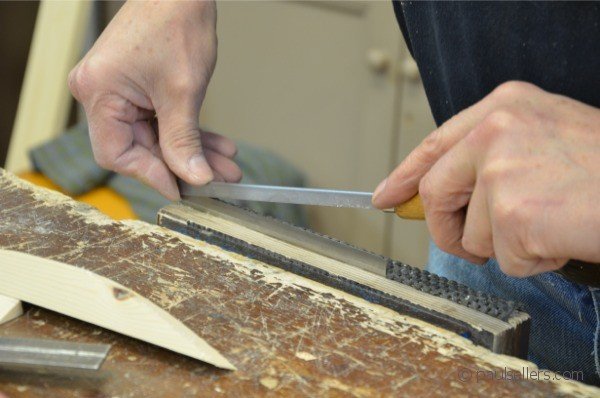

I own a Wenzloff 14″ X-cut saw, in the Harvey Peace line, and it is my favorite saw and my most used saw. Cuts like a dream, has great balance, and feels like an extension of my arm.
I have put off put off for the time being a Wenzloff. Was wondering what your experience has been with the Pax tenon saws. I needed a 14 PPI tenon filed crosscut before the year was out and saw the Pax in Lee Valley, so I went for it. Ebay is out of the question. Stateside these days there’s just too many collectors on Ebay reselling stuff, with talk about patinas, medallions, etc. I find its hard to find good deals on ebay on decent users. We’ll see how the Pax works out. It looks promising as its made of good steel (Sheffield) per the description in the catalog.
Pax and many others are made in Sheffield, England by a small firm called Thomas Flinn & Co. They make saws under many names and for many suppliers. Garlick, Lynx, E.T. Roberts & Lee and others. The company bought the names of other makers as they closed and then used those names in their line up of saws they make. I am glad that they took up the slack as the saw making industry wound to it’s slow halt.
It’s been several years since I tried out their saws to compare them for quality, sharpness and feel. They do use good materials and I would like to put them through their paces; cost of buying and testing tools gets prohibitive. I tested a US made panel saw by a leading maker last year and was very disappointed with the result, and I learned then that all saws and other tools have to be tested in the field and not for reviews. Every review in every magazine there is is tried at the bench in one session. That’s not realistic for me. Tools usually don’t fail in the first strokes of a saw or plane, they fail after a few months of use. Almost all of my reviews come after several months or years of daily use.
Paul, thank you for that really informative answer. Just the sort of
expansiveness I enjoy about your blogs. This is the kind of background that many of us starting out, such as myself, are short on. As you say, much information out there is based on tool reviews from magazine or web editors whose evaluations might not be completely free from the influence of their employers or sponsors. The good fortune for us woodworkers who follow your blogs is that we can be confident that a tool review or opinion from you will have been forged on the anvil of your own experience, that you have made it your own, and wish to preserve a legacy. Thanks again for all you do.
If I could add one thing to what Paul has said. The only negative I have about Pax saws, and I have used Pax and Garlick saws. The handles are very generic. They used to not be to bad, but they are all flat and more than likely CNC’s handles now. So, you may want to make yourself a new handle, it does make a difference. In general the opening for the hand is just way to big, so your hand just swims around and causes you to have to hold on tighter, which is not a good thing.
That’s true too. The lack of care there is reminiscent of the current Chinese made Spear and Jackson hand and tenon saws. It’s so disappointing to claim an inheritance going back to previous centuries without maintaining the standard or even raising the bar on the foundation of prized craftsmanship as some US makers like Wenzloff and others.
Bill, thanks for this. That is indeed disappointing and a shame that they would seem to make a quality product, and then fall down on something like the handle.
I did not realize that the handle’s opening as the hand fits in it
could cause you to grip the saw more tightly. But I can imagine how doing so can cause a loss of accuracy in your cuts. Thanks for the tip of making my own handle. Got to try making my own at some point now that you pointed this out.
I have a Pax panel saw that my wife got me for Christmas last year. While I’m not an experienced woodworker and haven’t used it daily for months as Paul describes I absolutely love it. I use it for cutting anything (for right or wrong). MDF, Plastic coated chipboard, hardwoods, pine and I can’t get over how it just does the job with little effort. I have a few long rip and crosscut saws that my wife’s grandfather owned. They need to be restored I’ll use my Pax as a standard to try and match as I work on them.
Is it an old Pax or a newly made one?
Newly made to order
I just dropped the $8 here in the states for the small Zona saw mentioned above, It’s a steal for the 10 pounds it costs in the UK. I’ve been building my collection of hand tools mostly through ebay and It’s great to find a product that works as well as this saw does. Played around with it for dovetailing in both Pine and Cherry, if your looking for a first dovetail saw save yourself the money out of the gate and give it a try.
You mentioned that the teeth are too small for sharpening but is the steel of sufficient quality for it to be worth filing them all off and re-toothing the plate to give the saw a 2nd life? Or using the plate as a scraper?
Yes, I covered this somewhere at one point.
id like to add a point on saw sharpening rob cosman is the only saw supplier that i know of that actually offers a saw sharpening service on his saws
Nice but, unless you live nearby, the shipping time &/or cost might prove prohibitive for many. Ashley Illes offer free sharpening of their tools – but if you use hand tools, you really need to learn to do this for yourself.
I was pleasantly surprised to find a sharpening company 8 country miles from where I live that will sharpen saws for £8 each* (not unreasonable but about the cost of a disposable hard-point saw), the guy even offered to pick them up. But perhaps better to learn to do it yourself from Paul’s videos. Then you can hand sharpen as many saws as you like, whenever you like/need to. Just get a Bahco or similar quality saw sharpening file (about £5), I find the smaller 4″ size most suitable for tenon/carcass/dovetails saws. The same or slightly bigger for my 22″ saws. An old Eclipse saw-set tool goes for about £3 + £3 shipping, not needed after ever sharpen but occasionally necessary. Per Paul’s advice, use the minimum set setting & use Paul’s 2 hammer technique to reduce set if the saw binds in the kerf.
*Not sure if he machine sharpens or hand sharpens. Warning: machine sharpening can be quite aggressive, removing a lot of steel, judging from some saws I have seen. Same with chainsaw sharpening.
Hi Paul, I wondered what you think of the Zona SA35/380 14-Teeth Dovetail Saw? With 14tpi, it could be sharpen – but is that too coarse for a saw of this diminutive size? Perhaps overlapping what might be better done with a small (8″/10″) tenon/back saw.
The Zona SA35/380 blade/plate is 8″ & 14TPI (vs. the Zona SA35/300 Homecraft Saw, which is ~6.5″ or 7″ and 24TPI).
I guess am trying to understand why you didn’t choose the SA35/380, which seems the more obvious choice for dove tailing to me – albeit £2 more expensive.
Paul,
What are your thoughts on a 14″ version of the Crown/Pax/Lynx Tenon saw in RIP?
12″ readily available, just wondering about size here.
Obviously there are tenons big enough to make a 14″ Tenon saw more useful than a 12″ but how often is that likely….?
I’m converting a kinked 20″ panel saw into a 16″ “Half-back” saw hopefully negating the need for a 14″ Tenon saw moot.
Thought?
Cheers,
Jeff
I do use a 14″ regularly in my daily working, especially for most tenon cutting. The 12″ will cut tenons fine but I like the added length of the 14″ and the extra weight/heft too. For me it is not an either or between these two sizes just a question of order of purchase. Now then, I also have a 16″ tenon saw which I love too.